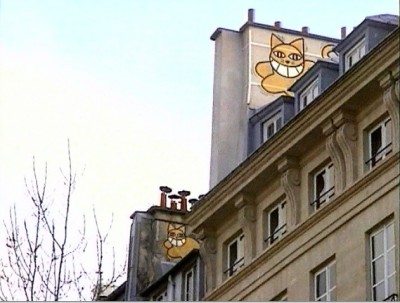
At 85 years old, I suppose it's not a surprise to see Chris Marker grappling with the new millennium in a way that feels as if it was being witnessed by a filmmaker in the 1980's. The Case of the Grinning Cat, his hour-long documentary on the public and political changes that have come in the first four years of 21st century both internationally and in his native France, feels, in contrast to some of his groundbreaking films of the 60's and 70's, twenty years behind. Marker's mode of observing the world has remained hands-off and his approach even has a keen similarity to an earlier film of his, Grin Without a Cat (1977).
It seems Marker has carried a very old-world disposition along with him, so his transition to video is somewhat dissonant. The film was aired on French television and understandably so; it doesn't look too far off from a low-budget PBS documentary. The images, as usual, are shot entirely by Marker and have a strictly on-the-fly feel, as if they were taken by a tourist. There is a motorcade of shaky footage as well as clumsy zooms and cuts. News footage, still photos, and intertitles are also cycled into the muffled aesthetic, making it a grab-bag of media matter surrounding events such as 9/11, the French political campaign of 2002 (between Jacques Chirac, a right-wing, and Lionel Jospin, a leftist), and the genesis of the Iraq War. In the midst of these events, Marker watches a graffiti image of his favorite animal, the cat, pop up sporadically in France on buildings, bridges, trees, and in metro stations. The cat is illustrated in sharp, bold lines, has a maniacal grin from cheek to cheek, is colored bright yellow, and is signed "M. Chat". Just as much as the mix of cultural happenings he documents on screen, this rapidly duplicating piece of street art is Marker's focus. He seems to be interested in the evolution of the symbol, at one point appearing haphazardly as if nestled inside tree bark, likening the cat to an owl, and then on a placard amidst a public protest on Parisian streets regarding Bush's decision to invade Iraq. The grinning cat matures from a whimsical street logo meant to elicit smiles from passersby to a far-reaching symbol of freedom making rounds on network news programs.
While Marker does describe this very transition quite plainly himself via intertitles, he still does not give one element in his film higher precedence than another, frequently raising a point and then moving on right when a more manipulative filmmaker would hammer this factoid home with a subjective stance. This is what lifts The Case of the Grinning Cat out of the vat of mediocrity that its aesthetics may suggest it belongs in. If one can tune out the terse narration that was added to the English-language release of the film (not a product of Marker whatsoever), what we get is a characteristic observation of society by a thought-provoking French documentarian. It's just that the film feels so minor and almost pedestrian in comparison to some of his more accomplished works.
0 comments:
Post a Comment